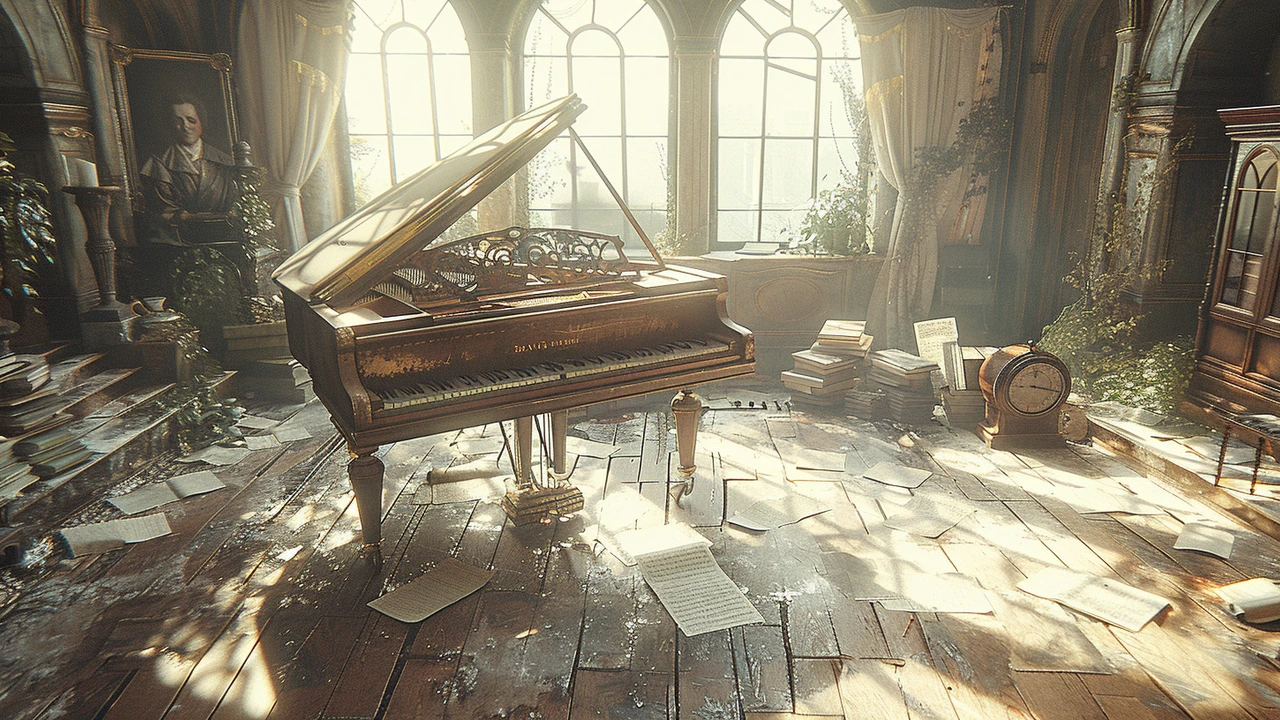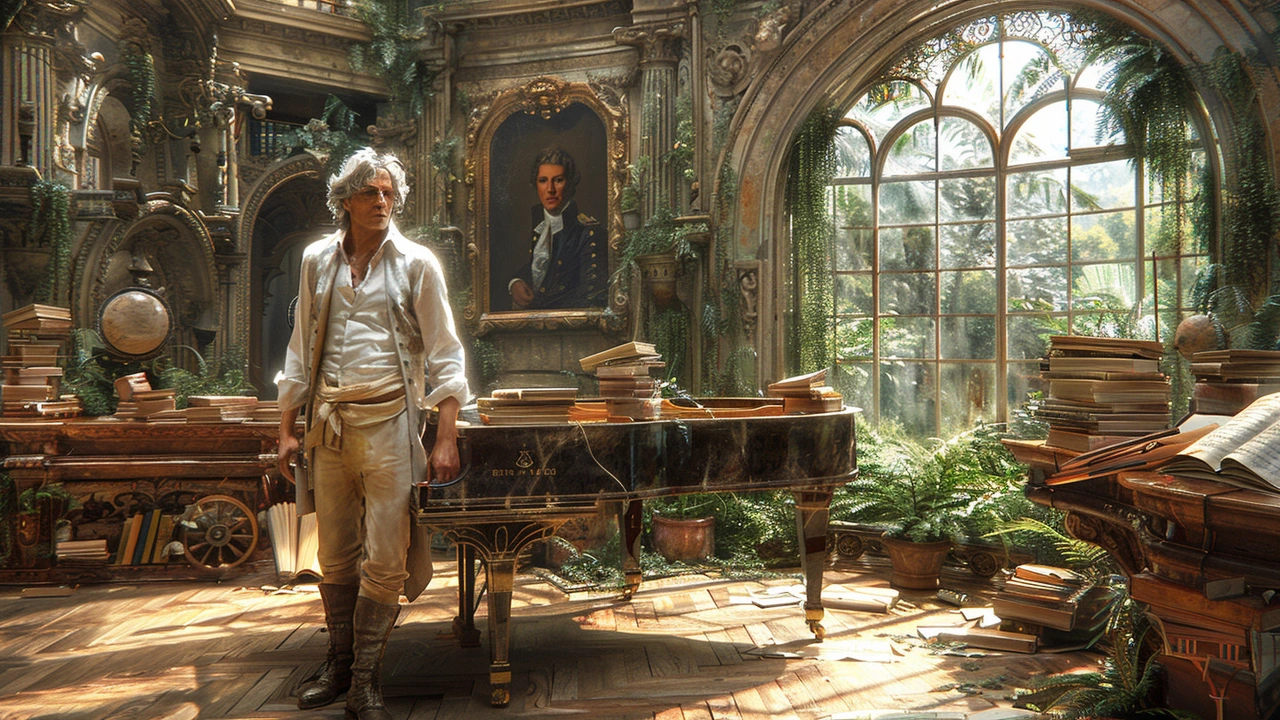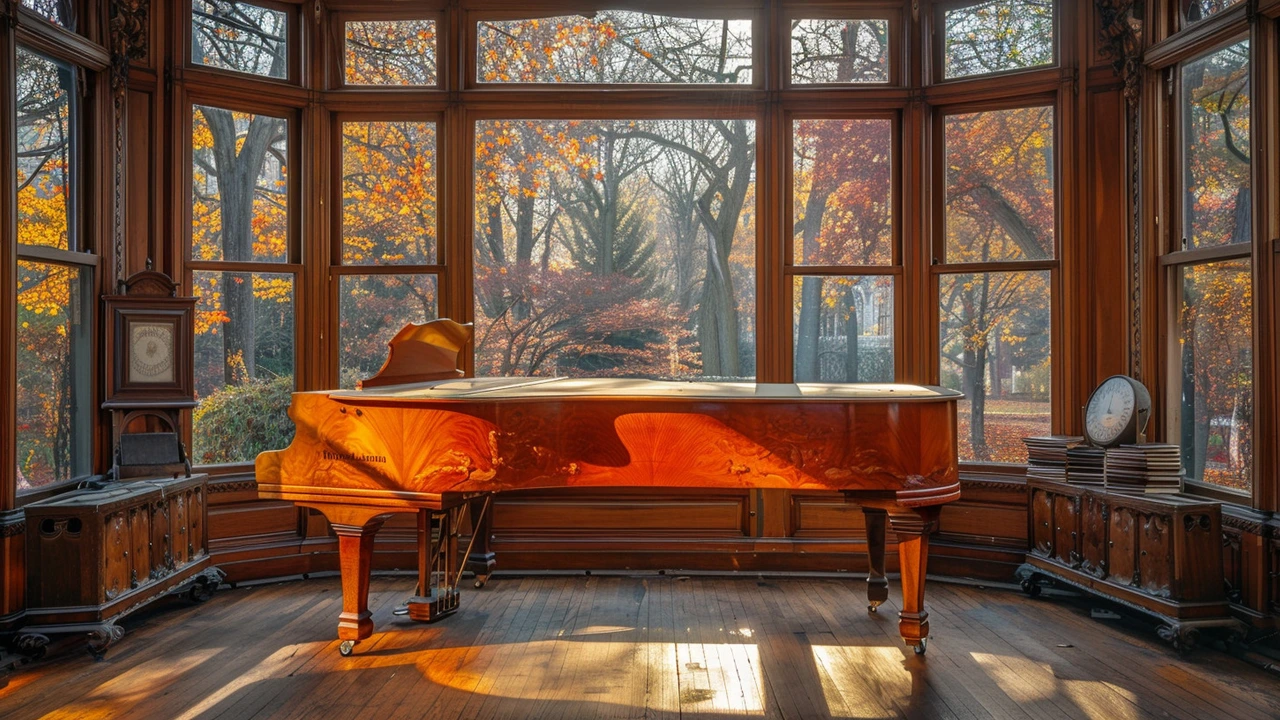The piano, a seemingly timeless instrument, has an unrivaled presence in the world of classical music. Its journey from humble beginnings to its current status as a central piece in concert halls is nothing short of fascinating.
The piano was born out of a need for an instrument that could combine the dynamic range of the harpsichord with the expressive potential of the clavichord. This evolution paved the way for its unique capability to convey a broad spectrum of emotions, from thunderous fortissimos to delicate pianissimos.
Thanks to its versatility, the piano attracted the genius of composers like Mozart, Beethoven, and Chopin, who crafted pieces that showcased its full potential. These compositions not only tested the skill of the pianist but also pushed the limits of the instrument itself.
Over the years, technological advances have continually improved the piano’s construction and sound. From the development of the modern grand piano to the introduction of digital pianos, each innovation has expanded the instrument's possibilities.
Beyond its technical aspects, the piano has had a profound cultural impact. It stands as a symbol of artistic expression and technical mastery, influencing music education and performance traditions across the globe.
For those inspired to pursue the piano, there are countless resources and tips available. From choosing the right instrument to mastering essential techniques, aspiring pianists have a wealth of information to guide their musical journey.
- The Origins and Evolution of the Piano
- Pioneering Composers and Masterpieces
- Technical Innovation and Sound
- The Piano’s Cultural Influence
- Practical Tips for Aspiring Pianists
The Origins and Evolution of the Piano
The story of the piano begins around the turn of the 18th century. Before the piano, keyboard instruments like the harpsichord and clavichord were prominent in European music. The harpsichord, while elegant, lacked dynamic range as it could not vary the volume of the sound produced. Conversely, the clavichord had expressive potential but insufficient power for larger performances. It was Bartolomeo Cristofori, an Italian instrument maker, who bridged this gap.
Cristofori’s creation, initially called the ‘gravicembalo col piano e forte,’ could produce both soft and loud sounds, thus being versatile. This instrument featured hammers that struck strings, producing a sound that could vary in loudness based on the force of the strike. The early 1700s saw him create several prototypes. Over the next few decades, the piano evolved with each iteration, gaining popularity in many European courts.
By the mid-18th century, the piano's design improved extensively. Innovators like Gottfried Silbermann introduced crucial advancements like the damper mechanism, which allowed for better control over the sustain of notes. Around the same time, piano-making centers in Germany, England, and France began refining the instrument’s design. With the introduction of the metal frame in 1825, pianos could withstand higher string tension, resulting in a louder and richer tone.
Early piano composers like Wolfgang Amadeus Mozart and Ludwig van Beethoven played significant roles in pushing the instrument’s expressive capabilities. Their compositions demanded broader dynamics and faster action that earlier pianos could not provide, compelling further enhancements. Beethoven’s later works, characterized by powerful, resonant chords, especially benefitted from the robust construction of the early 19th-century pianos.
During the 19th century, the Industrial Revolution brought about mass production techniques, making pianos more affordable and widespread. Companies like Steinway & Sons and Érard introduced innovations such as the cross-stringing (or over-stringing) technique, which allowed for greater string tension and improved sound quality. This period also saw the advent of the upright piano, smaller and more economical, fitting comfortably in urban homes.
“The piano is able to communicate the subtlest universal truths by means of wood, metal and vibrating air.” – Kenneth Miller
In the 20th century, the piano continued to evolve with new materials and technologies. The rise of electronic pianos and synthesizers introduced digital sound production, expanding the instrument’s versatility. Today, while traditional acoustic pianos remain treasured, digital pianos offer a range of features such as portability, varied instrumental sounds, and even connectivity to educational apps.
The evolution of the piano reflects a relentless pursuit of innovation and artistic expression. From royal courts and classical concert halls to jazz clubs and contemporary music studios, the piano’s journey is a testament to its unparalleled adaptability and enduring appeal.
Pioneering Composers and Masterpieces
The piano's journey through the annals of classical music is adorned with the brilliance of pioneering composers whose works have immortalized the instrument. These composers not only expanded the technical boundaries of the piano but also deepened its expressive potential, leaving a rich legacy of masterpieces for generations to admire and interpret.
One of the earliest and most influential figures in piano music was Wolfgang Amadeus Mozart. His compositions, such as the "Piano Sonata No. 11 in A Major, K. 331," are celebrated for their melodic elegance and structural clarity. Mozart's ability to blend simplicity with complexity in his piano works set a standard that many subsequent composers aspired to.
Ludwig van Beethoven is another monumental figure whose contributions to piano music cannot be overstated. His "Moonlight Sonata," formally known as

Technical Innovation and Sound
The piano has always been at the forefront of musical innovation, its design a marvel of engineering and artistry. The evolution of the piano over the centuries is a testament to the relentless pursuit of better sound and more responsive action by craftsmen and inventors.
One of the most significant innovations was the introduction of the cast iron frame in the 19th century. Before this development, pianos relied on wooden frames, which limited the tension that strings could withstand. The cast iron frame allowed strings to be tighter, producing a richer, more powerful sound that could fill larger concert halls. This advancement marked a significant leap in the instrument’s capability.
“The piano is able to convey the entire range of human emotion, thanks to centuries of innovation and refinement.” — John Broadwood
The development of the modern grand piano also brought changes in string arrangement. Overlapping strings in a cross-strung pattern not only saved space but created greater tonal complexity. This arrangement contributed to the exquisite resonance and sustain that the piano is known for today.
Another key innovation was the double escapement action, invented by Sébastien Érard in 1821. This mechanism allows hammers to hit strings multiple times in quick succession, enabling faster repetition of notes. This was a game-changer for composers and pianists, paving the way for more virtuosic and technically demanding music.
Materials used in pianos have also played a crucial role in their sound and durability. The hammers, originally covered with leather, later switched to high-quality felt, which provides a more nuanced and varied tonal palette. Similarly, the quality of the wood used in the soundboard—typically spruce—directly affects the instrument’s resonance and projection.
Today, technological advances continue to shape the piano in new ways. Digital pianos and hybrids combine traditional craftsmanship with digital technology to offer features like recording capabilities and customizable sounds. For instance, some high-end digital pianos even simulate the mechanical nuances of a grand piano’s action, providing an authentic playing experience.
Modern innovations are also making pianos more accessible. Silent pianos, which allow players to practice with headphones, are becoming increasingly popular. These instruments use sensors to capture the movement of keys and hammers, translating it into digital sound while preserving the tactile feel of playing an acoustic piano.
The relentless pursuit of innovation in the design and construction of the piano ensures that it remains a central figure in classical music. Whether it’s the towering concert grand or the compact digital model, each piano today carries within it centuries of ingenuity and a dedication to perfecting the art of sound.
The Piano’s Cultural Influence
The piano has transcended its role as a mere musical instrument to become a vital cultural icon. Its influence stretches far beyond the concert halls and symphony orchestras, infiltrating various aspects of society and culture.
One of the most profound impacts of the piano has been in the realm of music education. Learning to play the piano is often seen as a foundational step in music instruction. Because of its range and versatility, it helps students understand the basics of music theory and composition. Schools and conservatories around the world have integrated piano lessons into their curricula, reinforcing its indispensable role in shaping musicians of all kinds.
The piano has also been a staple in homes, symbolizing not just musical aspiration but also social status. During the 19th and early 20th centuries, owning a piano was considered a mark of sophistication and cultural refinement. Families would gather around the piano for entertainment, making it a central fixture in the domestic scene. This period saw a surge in the production of sheet music, making popular songs and classical pieces accessible to amateur musicians. The phrase “parlor music” emerged, highlighting the domestic and social importance of the piano.
In the realm of popular culture, the piano has continuously left its mark. Several iconic moments in film and television feature the piano as a central element. For instance, the timeless image of Sam playing “As Time Goes By” in the movie “Casablanca” or Tom Hanks performing “Chopsticks” on a giant floor piano in the film “Big” are etched into our collective memory. These scenes underscore the piano’s enduring appeal and its ability to evoke powerful emotions.
The influence of the piano extends to various musical genres as well. In jazz, for instance, the piano is an essential instrument, forming the backbone of countless jazz standards. Artists like Duke Ellington and Thelonious Monk used the piano to explore complex harmonies and improvisations, pushing the boundaries of what the instrument could achieve. Similarly, in rock and pop music, legendary musicians such as Elton John and Billy Joel have demonstrated the piano’s versatility, crafting hits that resonate across generations.
Famed classical pianist Lang Lang once said, “The piano is the X-ray of the musician’s heart; you can see everything’s radiated through the instrument.” This quote aptly captures the deep emotional connection musicians and audiences have with the piano. It’s not just the physical act of playing that touches people; it’s the way the music produced on a piano can convey the breadth of human experience, from joy to sorrow, with unparalleled nuance.
Culturally speaking, the piano has also sparked significant innovations. The advent of the player piano in the early 1900s allowed people to experience complex compositions without needing to play themselves. This invention laid the groundwork for later technological advances in music playback and reproduction, including the development of the digital piano. Digital pianos have made high-quality sound more accessible and portable, ensuring the piano’s relevance in the modern era. As of 2024, the global market for digital pianos is valued at over $1 billion, indicating sustained interest and growth.
Overall, the piano stands as a testament to the power of music to shape and reflect cultural values. Whether through education, home entertainment, or its pivotal role in various musical genres, the piano’s influence is both deep and wide-reaching. Its ability to connect with people on an emotional level ensures that it will continue to be a central part of our cultural landscape for years to come.

Practical Tips for Aspiring Pianists
Diving into the world of piano playing is an exciting journey filled with both challenges and rewards. Whether you are a beginner or looking to refine your skills, there are some essential tips to help navigate your musical path. The piano is a versatile and powerful instrument that can express a wide range of emotions and styles.
First and foremost, selecting the right instrument to practice on is crucial. If you are just starting, consider a well-maintained upright piano or a digital piano with weighted keys. The feel of the keys and the responsiveness of the instrument can significantly impact your playing technique and overall experience. For those who are more advanced, investing in a grand piano can provide a more dynamic range and richer sound.
Establishing a consistent practice routine is key to progress. Aim to practice daily, even if it’s for a short period. Regular practice helps in building muscle memory and improving finger strength and coordination. Breaking down your practice sessions into focused segments can be highly effective. Spend time on scales and arpeggios to warm up, then move on to working on specific pieces. Ensure you also allocate some time to sight-reading and exploring new repertoire.
Another critical aspect is paying attention to technique. Proper hand positioning and posture can prevent injuries and enhance your playing. Keep your wrists relaxed and fingers curved. Sit at the piano bench with a straight back and position yourself at a height where your forearms are parallel to the floor. Practicing these habits early on can save you from developing bad techniques.
“Without craftsmanship, inspiration is a mere reed shaken in the wind.” - Johannes Brahms
Listening actively to various piano performances can also be incredibly beneficial. It exposes you to different styles and interpretations, inspiring you to experiment with your own play. Attend live concerts or watch performances online to observe professionals and their techniques.
Using technology to your advantage can make learning more comprehensive. There are numerous apps and online platforms that offer tutorials, sheet music, and interactive lessons. These resources can provide additional support and complement your traditional lessons. Recording your practice sessions and listening to playback can help identify areas needing improvement.
Don’t overlook the value of a good teacher. Personalized feedback and structured lessons can greatly enhance your learning curve. A teacher can provide guidance, correct mistakes, and offer new challenges that keep you motivated. If in-person lessons aren’t feasible, consider virtual lessons from qualified instructors.
Building a diverse repertoire is another tip for aspiring pianists. It not only makes practice more enjoyable but also equips you for different performance settings. Include classical pieces, jazz, and contemporary music. Each genre brings its own set of skills and techniques, enriching your overall musicality.
Last but definitely not least, stay patient and be kind to yourself. Mastering the piano is a gradual process, and everyone progresses at their own pace. Celebrate small milestones along the way, whether it's learning a new piece or perfecting a difficult passage. Keeping a positive and persistent attitude is crucial for long-term success.

